Impact of Wind Speed on Response of Diffusion-Type Radon-Thoron Detectors to Thoron
Abstract
1. Introduction
2. Materials and Methods
2.1. Detectors
2.2. Experiment
2.3. Analysis
3. Results
4. Discussion
5. Conclusions
Author Contributions
Funding
Acknowledgments
Conflicts of Interest
Abbreviations
| A | Area of the air inlet(s) of the detector (RADUETs or AlphaGUARD) |
| Cbg | Concentration indicated by AlphaGUARD before starting exposure to thoron |
| Cex | Concentration indicated by AlphaGUARD during exposure to thoron |
| CTn, in | Thoron concentration in diffusion chamber of the detector (RADUETs or AlphaGUARD) |
| CTn, out | Thoron concentration in a thoron calibration chamber |
| d | Thickness of a porous medium (filter or sponge) |
| Dp | Diffusion coefficient in a porous medium (filter or sponge) |
| Nbg | Background track density on CR-39 |
| Nex | Track density on CR-39 formed after exposure of RADUETs to thoron is completed |
| RA | Responses to thoron for AlphaGUARD |
| RR | Responses to thoron for RADUETs |
| t | Time |
| T | Time for exposure of RADUETs to thoron |
| u | Air velocity induced by pressure gradient in a porous medium |
| V | Volume of the detector (RADUETs or AlphaGUARD) |
| γ | Air exchange rate of the detector (RADUETs or AlphaGUARD) |
| λ | Decay constant of thoron |
References
- United Nations Scientific Committee on the Effects of Atomic Radiation (UNSCEAR). Sources and Effects of Ionizing Radiation, UNSCEAR 2008 Report to the General Assembly with Scientific Annexes; United Nations: New York, NY, USA, 2010; Volume 1. [Google Scholar]
- Omori, Y.; Hosoda, M.; Takahashi, F.; Sanada, T.; Hirao, S.; Ono, K.; Furukawa, M. Japanese population dose from natural radiation. J. Radiol. Prot. 2020, in press. [Google Scholar] [CrossRef] [PubMed]
- Porstendörfer, J. Properties and behaviour of radon and thoron and their decay products in the air. J. Aerosol Sci. 1994, 25, 219–263. [Google Scholar] [CrossRef]
- United Nations Scientific Committee on the Effects of Atomic Radiation (UNSCEAR). Sources and Effects of Ionizing Radiation, UNSCEAR 2000 Report to the General Assembly with Scientific Annexes; United Nations: New York, NY, USA, 2000; Volume 1. [Google Scholar]
- World Health Organization (WHO). WHO Handbook on Indoor Radon: A Public Health Perspective; WHO: Geneva, Switzerland, 2009. [Google Scholar]
- International Commission on Radiological Protection (ICRP). Radiological Protection against Radon Exposure. ICRP Publication 126. Annals of the ICRP 43(3); SAGE Publications: London, UK, 2014. [Google Scholar]
- Hosoda, M.; Kudo, H.; Iwaoka, K.; Yamada, R.; Suzuki, T.; Tamakuma, Y.; Tokonami, S. Characteristic of thoron (220Rn) in environment. Appl. Radiat. Isot. 2017, 120, 7–10. [Google Scholar] [CrossRef] [PubMed]
- Chen, J.; Harley, N.H. A review of indoor and outdoor radon equilibrium factors–part I: 222Rn. Health Phys. 2018, 115, 490–499. [Google Scholar] [CrossRef]
- Chen, J.; Harley, N.H. A review of indoor and outdoor radon equilibrium factors–part II: 220Rn. Health Phys. 2018, 115, 500–506. [Google Scholar] [CrossRef]
- Tokonami, S.; Sun, Q.; Akiba, S.; Zhuo, W.; Furukawa, M.; Ishikawa, T.; Hou, C.; Zhang, S.; Narazaki, Y.; Ohji, B.; et al. Radon and thoron exposures for cave residents in Shanxi and Shaanxi Provinces. Radiat. Res. 2004, 162, 390–396. [Google Scholar] [CrossRef]
- Kudo, H.; Tokonami, S.; Omori, Y.; Ishikawa, T.; Iwaoka, K.; Sahoo, S.K.; Akata, N.; Hosoda, M.; Wanabongse, P.; Pornnumpa, C.; et al. Comparative dosimetry for radon and thoron in high background radiation areas in China. Radiat. Prot. Dosim. 2015, 167, 155–159. [Google Scholar] [CrossRef]
- Omori, Y.; Prasad, G.; Sorimachi, A.; Sahoo, S.K.; Ishikawa, T.; Sagar, D.V.; Ramola, R.C.; Tokonami, S. Long-term measurements of residential radon, thoron, and thoron progeny concentrations around the Chhatrapur placer deposit, a high background radiation area in Odisha, India. J. Environ. Radioact. 2016, 162–163, 371–378. [Google Scholar] [CrossRef]
- Omori, Y.; Tokonami, S.; Sahoo, S.K.; Ishikawa, T.; Sorimachi, A.; Hosoda, M.; Kudo, H.; Pornnumpa, C.; Nair, R.R.K.; Jayalekshmi, P.A.; et al. Radiation dose due to radon and thoron progeny inhalation in high-level natural radiation areas of Kerala, India. J. Radiol. Prot. 2017, 37, 111–126. [Google Scholar] [CrossRef]
- Meisenberg, O.; Mishra, R.; Joshi, M.; Gierl, S.; Rout, R.; Guo, L.; Agarwal, T.; Kanse, S.; Irlinger, J.; Sapra, B.K.; et al. Radon and thoron inhalation doses in dwellings with earthen architecture: Comparison of measurement methods. Sci. Total Environ. 2017, 579, 1855–1862. [Google Scholar] [CrossRef]
- Semwal, P.; Agarwal, T.K.; Singh, K.; Joshi, M.; Gusain, G.S.; Sahoo, B.K.; Ramola, R.C. Indoor inhalation dose assessment for thoron-rich regions of Indian Himalayan belt. Environ. Sci. Pollut. Res. 2019, 26, 4855–4866. [Google Scholar] [CrossRef] [PubMed]
- Tokonami, S.; Yang, M.; Sanada, T. Contribution from thoron on the response of passive radon detectors. Health Phys. 2001, 80, 612–615. [Google Scholar] [CrossRef] [PubMed]
- Ishikawa, T. Effects of thoron on a radon detector of pulse-ionization chamber type. Radiat. Prot. Dosim. 2004, 108, 327–330. [Google Scholar] [CrossRef] [PubMed]
- Zhuo, W.; Tokonami, S.; Yonehara, H.; Yamada, Y. A simple passive monitor for integrating measurements of indoor thoron concentrations. Rev. Sci. Instrum. 2002, 73, 2877–2881. [Google Scholar] [CrossRef]
- Tokonami, S.; Takahashi, H.; Kobayashi, Y.; Zhuo, W. Up-to-date radon-thoron discriminative detector for a large scale survey. Rev. Sci. Instrum. 2005, 76, 113505. [Google Scholar] [CrossRef]
- Sahoo, B.K.; Sapra, B.K.; Kanse, S.D.; Gaware, J.J.; Mayya, Y.S. A new pin-hole discriminated 222Rn/220Rn passive measurement device with single entry face. Radiat. Meas. 2013, 58, 52–60. [Google Scholar] [CrossRef]
- Ward, W.J., III; Fleischer, R.L.; Mogro-Campero, A. Barrier technique for separate measurement of radon isotopes. Rev. Sci. Instrum. 1977, 48, 1440–1441. [Google Scholar] [CrossRef]
- Iida, T.; Nurishi, R.; Okamoto, K. Passive integrating 222Rn and 220Rn cup monitors with CR-39 detectors. Environ. Int. 1996, 22 (Suppl. 1), 641–647. [Google Scholar] [CrossRef]
- Fleischer, R.L.; Giard, W.R.; Turner, L.G. Membrane-based thermal effects in 222Rn dosimetry. Radiat. Meas. 2000, 32, 325–328. [Google Scholar] [CrossRef]
- Pressyanov, D.; Dimitrov, D. The problem with temperature dependence of radon diffusion chambers with anti-thoron barrier. Rom. J. Phys. 2020, 65, 801. [Google Scholar]
- Sorimachi, A.; Tokonami, S.; Omori, Y.; Ishikawa, T. Performance test of passive radon-thoron discriminative detectors on environmental parameters. Radiat. Meas. 2012, 47, 438–442. [Google Scholar] [CrossRef]
- Omori, Y.; Shimo, M.; Janik, M.; Ishikawa, T.; Yonehara, H. Variable strength in thoron interference for a diffusion-type radon monitor depending on ventilation of the outer air. Int. J. Environ. Res. Public Health 2020, 17, 974. [Google Scholar] [CrossRef] [PubMed]
- Yasuoka, Y.; Sorimachi, A.; Ishikawa, T.; Hosoda, M.; Tokonami, S.; Fukuhori, N.; Janik, M. Separately measuring radon and thoron concentrations exhaled from soil using AlphaGUARD and liquid scintillation counter methods. Radiat. Prot. Dosim. 2010, 141, 412–415. [Google Scholar] [CrossRef] [PubMed]
- Tripathi, R.M.; Sumesh, C.G.; Vinod Kumar, A.; Puranik, V.D. Application of thoron interference as a tool for simultaneous measurement of radon and thoron with a pulse ionisation chamber. Radiat. Prot. Dosim. 2013, 155, 155–160. [Google Scholar] [CrossRef]
- Jónás, J.; Sas, Z.; Vaupotic, J.; Kocsis, E.; Somlai, J.; Kovács, T. Thoron emanation and exhalation of Slovenian soils determined by a PIC detector-equipped radon monitor. Nukleonika 2016, 61, 379–384. [Google Scholar] [CrossRef]
- Kochowska, E.; Kozak, K.; Kozłowska, B.; Mazur, J.; Dorda, J. Test measurements of thoron concentration using two ionization chambers AlphaGUARD vs. radon monitor RAD7. Nukleonika 2009, 54, 189–192. [Google Scholar]
- Sumesh, C.G.; Vinod Kumar, A.; Tripathi, R.M.; Puranik, V.D. Comparison study and thoron interference test of different radon monitors. Radiat. Prot. Dosim. 2013, 153, 309–315. [Google Scholar] [CrossRef]
- Omori, Y.; Janik, M.; Sorimachi, A.; Ishikawa, T.; Tokonami, S. Effects of air exchange property of passive-type radon-thoron discriminative detectors on performance of radon and thoron measurements. Radiat. Prot. Dosim. 2012, 152, 140–145. [Google Scholar] [CrossRef]
- Pornnumpa, C.; Oyama, Y.; Iwaoka, K.; Hosoda, M.; Tokonami, S. Development of radon and thoron exposure systems at Hirosaki University. Radiat. Environ. Med. 2018, 7, 13–20. [Google Scholar]
- Sorimachi, A.; Sahoo, S.K.; Tokonami, S. Generation and control of thoron emanated from lantern mantles. Rev. Sci. Instrum. 2009, 80, 015104. [Google Scholar] [CrossRef]
- Tokonami, S.; Yang, M.; Yonehara, H.; Yamada, Y. Simple, discriminative measurement technique for radon and thoron concentrations with a single scintillation cell. Rev. Sci. Instrum. 2002, 73, 69–72. [Google Scholar] [CrossRef]
- Lorenzi, A. Laminar, turbulent, and transition flow in porous sintered media. Meccanica 1975, 10, 75–77. [Google Scholar] [CrossRef]
- Basak, P. Non-Darcy flow and its implications to seepage problems. J. Irrigation Drainage Div. 1977, 103, 459–473. [Google Scholar]
- Bear, J. Dynamics of Fluids in Porous Media; Dover Publications, Inc.: New York, NY, USA, 1988; pp. 119–194. [Google Scholar]
- Belforte, G.; Raparelli, T.; Viktorov, V.; Trivella, A. Permeability and inertial coefficients of porous media for air bearing feeding systems. J. Tribol. 2007, 129, 705–711. [Google Scholar] [CrossRef]
- Macini, P.; Mesini, E.; Viola, R. Laboratory measurements of non-Darcy flow coefficients in natural and artificial unconsolidated porous media. J. Petrol. Sci. Eng. 2011, 77, 365–374. [Google Scholar] [CrossRef]
- Gargioni, E.; Honig, A.; Röttger, A. Development of a calibration facility for measurements of the thoron activity concentration. Nucl. Instrum. Meth. Phys. Res. A 2003, 506, 166–172. [Google Scholar] [CrossRef]
- Sorimachi, A.; Ishikawa, T.; Janik, M.; Tokonami, S. Quality assurance and quality control for thoron measurement at NIRS. Radiat. Prot. Dosim. 2010, 141, 367–370. [Google Scholar] [CrossRef]
- Zhao, C.; Zhuo, W.; Chen, B.; Zhang, H. Characteristic and performance of a simple thoron chamber. Radiat. Prot. Dosim. 2010, 141, 444–447. [Google Scholar] [CrossRef]
- Jílek, K.; Hýža, M.; Kotík, L.; Thomas, J.; Tomášek, L. International intercomparison of measuring instruments for radon/thoron gas and radon short-lived daughter products in the NRPI Prague. Radiat. Prot. Dosim. 2014, 160, 154–159. [Google Scholar] [CrossRef]
- Janik, M.; Tokonami, S.; Kranrod, C.; Sorimachi, A.; Ishikawa, T.; Hassan, N.M. International intercomparisons of integrating radon/thoron detectors with the NIRS radon/thoron chambers. Radiat. Prot. Dosim. 2010, 141, 436–439. [Google Scholar] [CrossRef]
- Janik, M.; Ishikawa, T.; Omori, Y.; Kavasi, N. Invited article: Radon and thoron intercomparison experiments for integrated monitors at NIRS, Japan. Rev. Sci. Instrum. 2014, 85, 022001. [Google Scholar] [CrossRef] [PubMed]
- Janik, M.; Tokonami, S.; Iwaoka, K.; Karunakara, N.; Trilochana, S.; Mohan, M.P.; Kumara, S.; Yashodhara, I.; Zhuo, W.; Zhao, C.; et al. Comparison of radon and thoron concentration measuring systems among Asian countries. Int. J. Environ. Res. Public Health 2019, 16, 5019. [Google Scholar] [CrossRef] [PubMed]
- Szeiler, G.; Somlai, J.; Ishikawa, T.; Omori, Y.; Mishra, R.; Sapra, B.K.; Mayya, Y.S.; Tokonami, S.; Csordás, A.; Kovács, T. Preliminary results from an indoor radon thoron survey in Hungary. Radiat. Prot. Dosim. 2012, 152, 243–246. [Google Scholar] [CrossRef] [PubMed]
- Kávási, N.; Vigh, T.; Németh, C.; Ishikawa, T.; Omori, Y.; Janik, M.; Yonehara, H. Invited article: In situ comparison of passive radon-thoron discriminative monitors at subsurface workplaces in Hungary. Rev. Sci. Instrum. 2014, 85, 022002. [Google Scholar] [CrossRef]
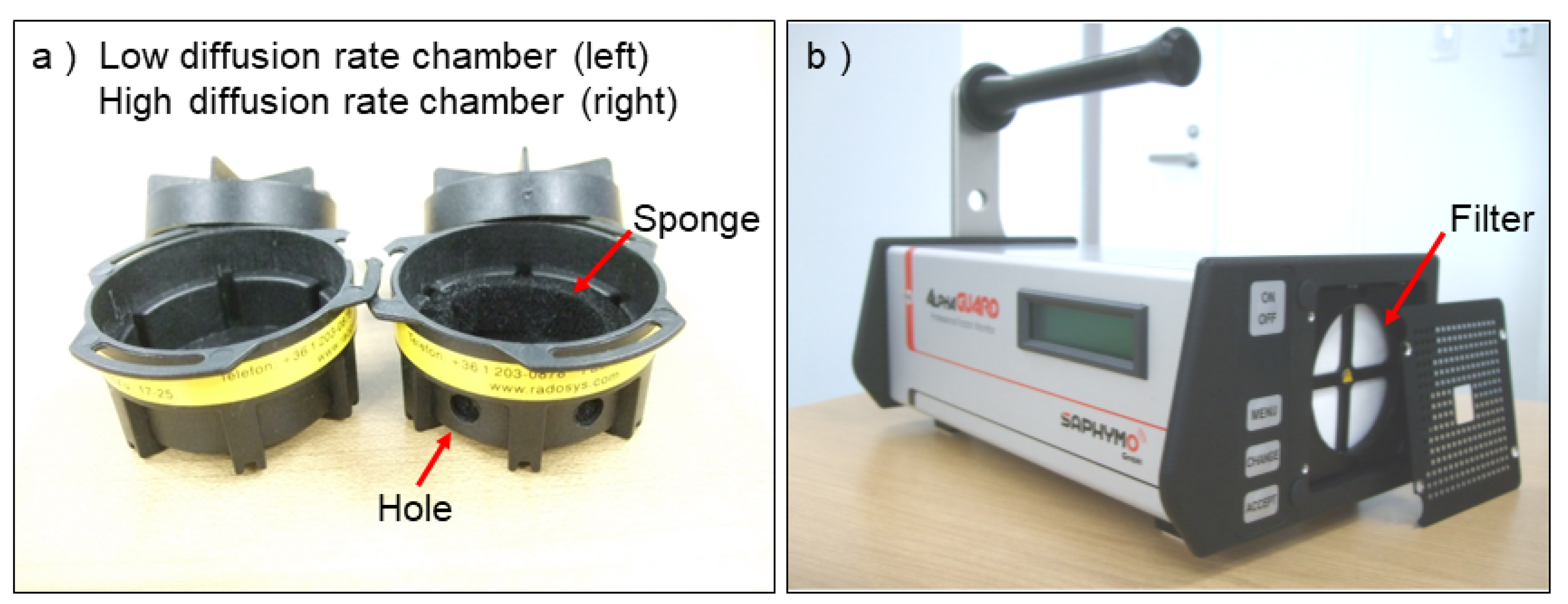
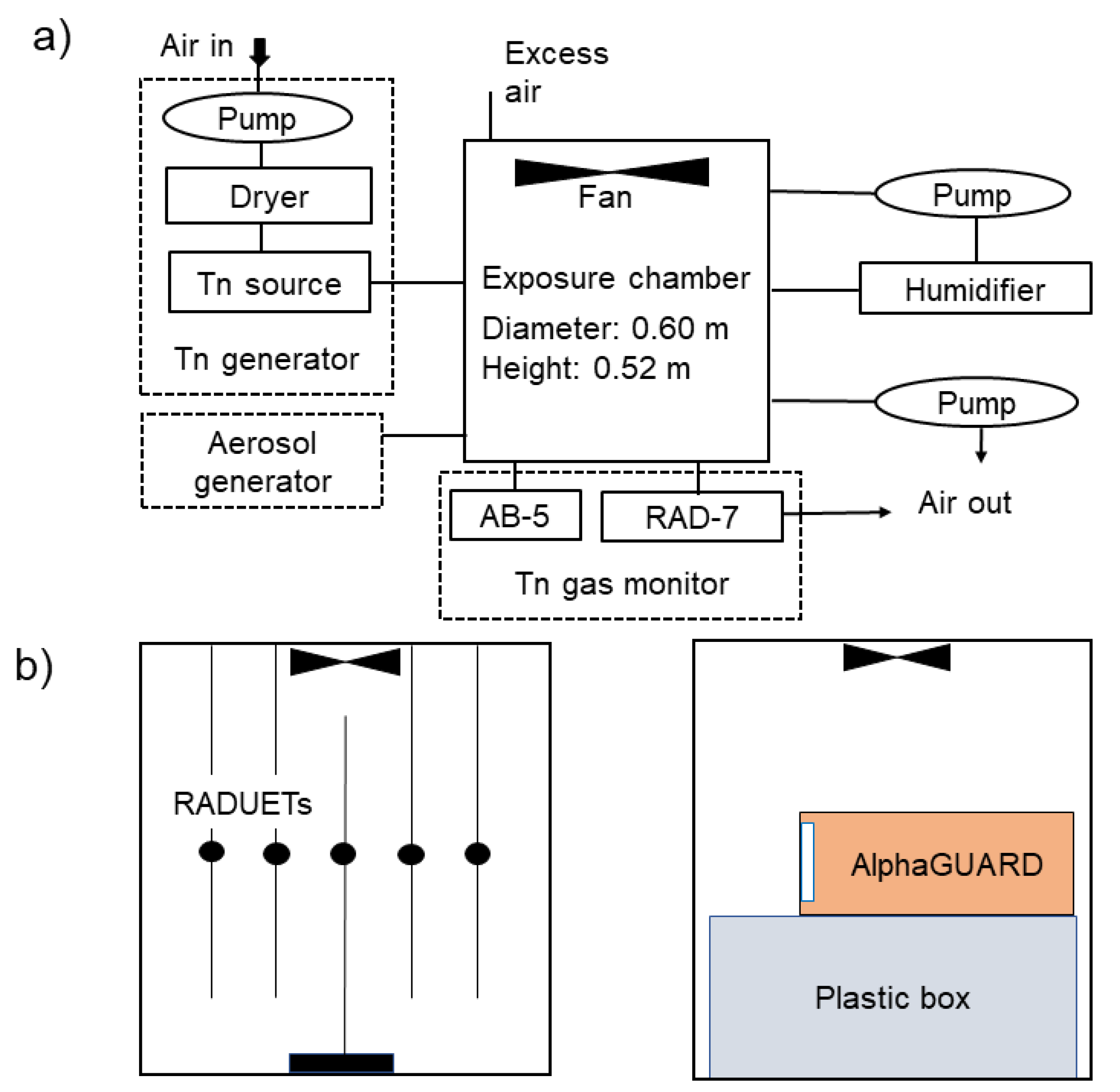
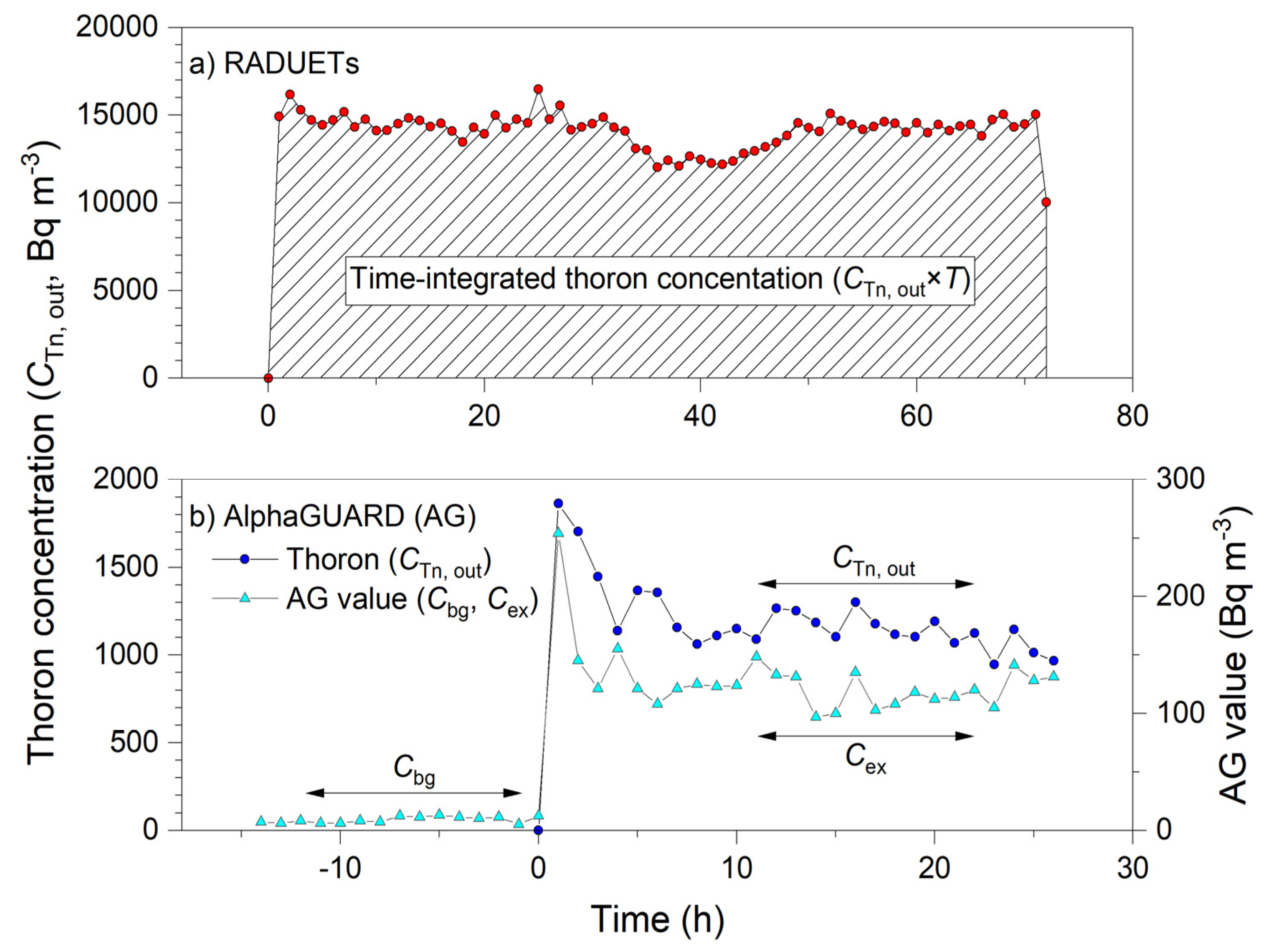
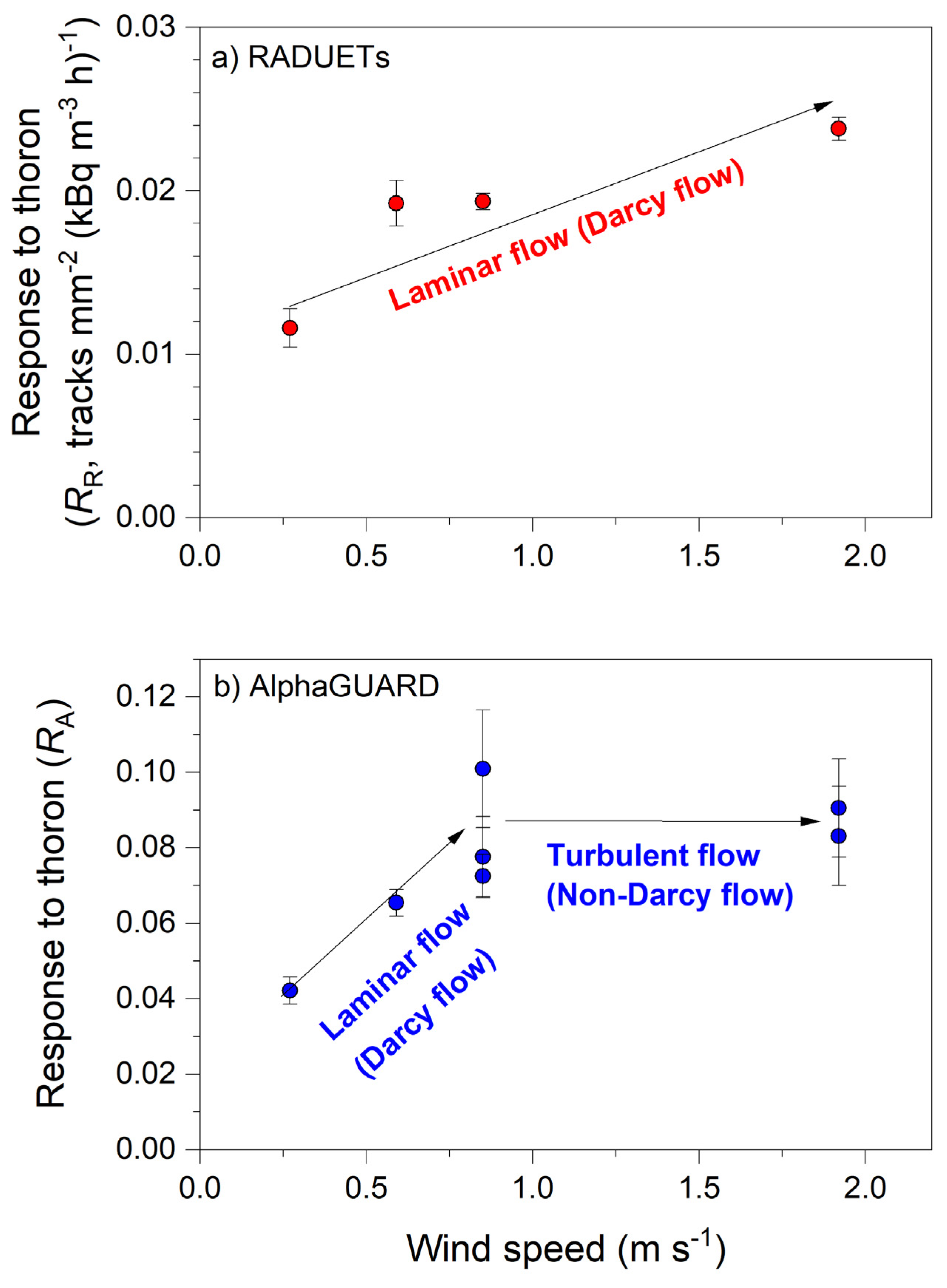
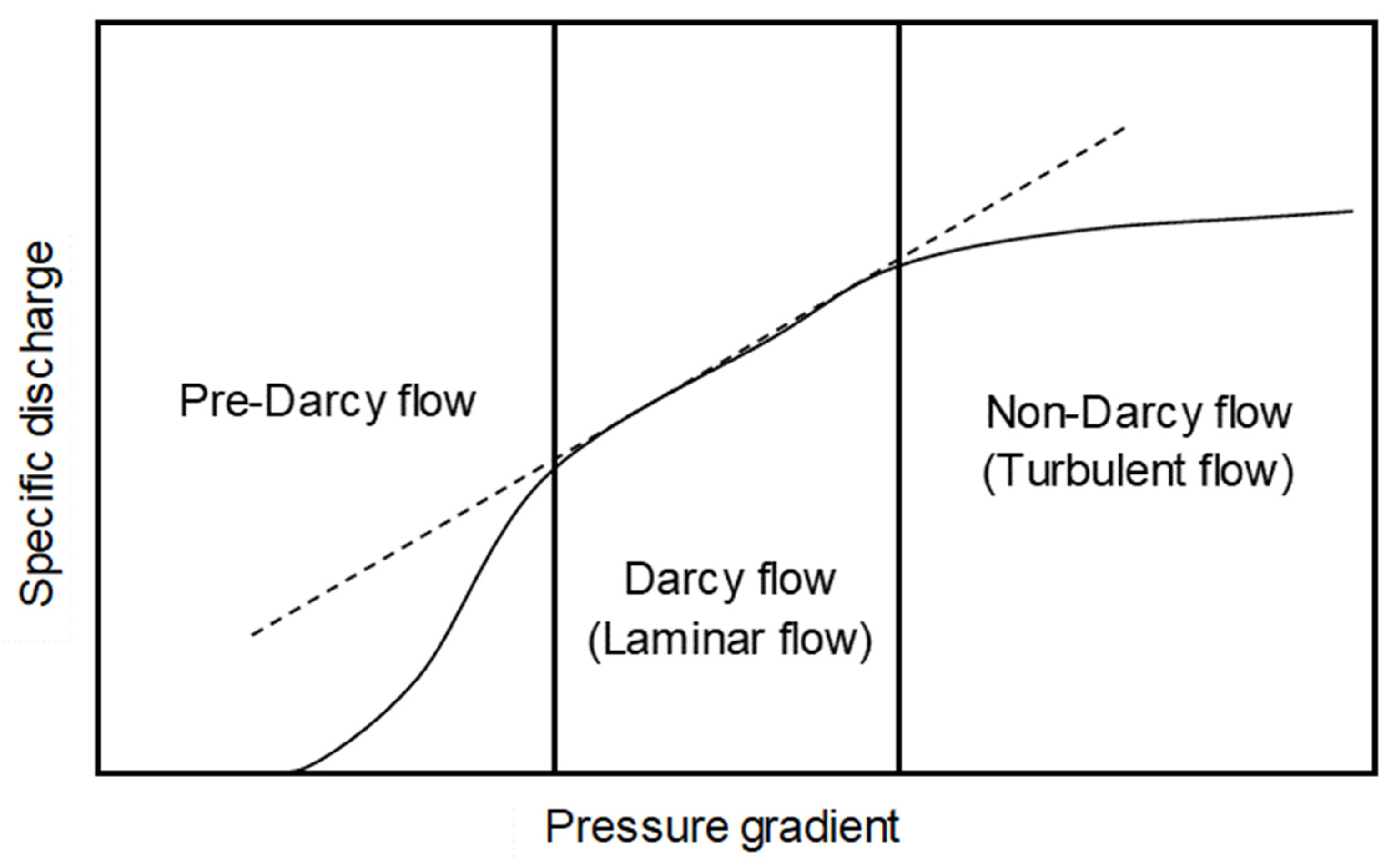
| Rotational Speed Level | Wind Speed (m s−1) | ||
|---|---|---|---|
| Center 1 | Near Wall 1 | Average 2 | |
| Very low | 0.33 ± 0.01 | 0.20 ± 0.02 | 0.27 |
| Low | 0.75 ± 0.02 | 0.44 ± 0.03 | 0.59 |
| Reference | 0.85 ± 0.05 | 0.85 ± 0.05 | 0.85 |
| High | 1.84 ± 0.05 | 2.00 ± 0.06 | 1.92 |
| RADUETs | |||||
| Wind Speed (m s−1) | Exposure Time (T, h) | Time-Integrated Thoron Concentration (CTn, out × T, kBq m−3 h) | Net Track Density (Nex–Nbg, tracks mm−2) 1 | Response to Thoron (RR, tracks mm−2 (kBq m−3 h)−1) | |
| 0.27 | 71 | 1082 | 12.6 ± 1.3 | 0.012 ± 0.001 | |
| 0.59 | 82 | 1281 | 24.6 ± 1.8 | 0.019 ± 0.001 | |
| 0.85 | 72 | 1016 | 19.7 ± 0.5 | 0.019 ± 0.001 | |
| 1.92 | 87 | 1007 | 24.0 ± 0.7 | 0.024 ± 0.001 | |
| AlphaGUARD | |||||
| Wind Speed (m s−1) | Exposure Time (T, h) | Thoron Concentration (CTn, out, Bq m−3) 2 | AlphaGUARD Value (Bq m−3) 2 | Response to Thoron (RA) | |
| Cex | Cbg | ||||
| 0.27 | 21 | 12752 ± 359 | 549 ± 42 | 11 ± 3 | 0.042 ± 0.004 |
| 0.59 | 17 | 12294 ± 323 | 816 ± 37 | 11 ± 3 | 0.065 ± 0.003 |
| 0.85 | 16 | 932 ± 80 | 98 ± 12 | 4 ± 2 | 0.101 ± 0.016 |
| 0.85 | 17 | 1049 ± 65 | 89 ± 9 | 8 ± 3 | 0.078 ± 0.011 |
| 0.85 | 20 | 12254 ± 680 | 900 ± 50 | 11 ± 3 | 0.073 ± 0.006 |
| 1.92 | 12 | 1165 ± 76 | 115 ± 13 | 9 ± 3 | 0.091 ± 0.013 |
| 1.92 | 15 | 1014 ± 117 | 94 ± 9 | 10 ± 3 | 0.083 ± 0.013 |
© 2020 by the authors. Licensee MDPI, Basel, Switzerland. This article is an open access article distributed under the terms and conditions of the Creative Commons Attribution (CC BY) license (http://creativecommons.org/licenses/by/4.0/).
Share and Cite
Omori, Y.; Tamakuma, Y.; Nugraha, E.D.; Suzuki, T.; Saputra, M.A.; Hosoda, M.; Tokonami, S. Impact of Wind Speed on Response of Diffusion-Type Radon-Thoron Detectors to Thoron. Int. J. Environ. Res. Public Health 2020, 17, 3178. https://doi.org/10.3390/ijerph17093178
Omori Y, Tamakuma Y, Nugraha ED, Suzuki T, Saputra MA, Hosoda M, Tokonami S. Impact of Wind Speed on Response of Diffusion-Type Radon-Thoron Detectors to Thoron. International Journal of Environmental Research and Public Health. 2020; 17(9):3178. https://doi.org/10.3390/ijerph17093178
Chicago/Turabian StyleOmori, Yasutaka, Yuki Tamakuma, Eka Djatnika Nugraha, Takahito Suzuki, Miki Arian Saputra, Masahiro Hosoda, and Shinji Tokonami. 2020. "Impact of Wind Speed on Response of Diffusion-Type Radon-Thoron Detectors to Thoron" International Journal of Environmental Research and Public Health 17, no. 9: 3178. https://doi.org/10.3390/ijerph17093178
APA StyleOmori, Y., Tamakuma, Y., Nugraha, E. D., Suzuki, T., Saputra, M. A., Hosoda, M., & Tokonami, S. (2020). Impact of Wind Speed on Response of Diffusion-Type Radon-Thoron Detectors to Thoron. International Journal of Environmental Research and Public Health, 17(9), 3178. https://doi.org/10.3390/ijerph17093178








